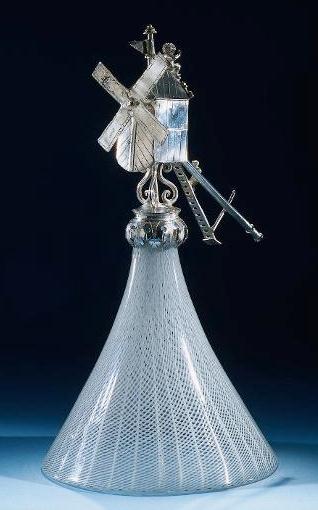
4 7/8th inches tall to roof’s ridge line.
Windmill cups:
These kinds of cups, mostly of silver, some with glass and silver (see last photo) and mostly of Dutch origin, were usually used as follows: One of the drinkers (usually there were several involved) would invert the cup and would fill the cup up with whatever was the home’s choice of schnapps or liquor. Then he’d spin the windmill vanes by using his fingers. This action gets the vanes started in rotation; he then had to drink the contents of the cup before the vanes stopped going around. If not, then he had to pay some type of penalty, which was determined by prior agreement and which number the pointer stopped on. The small silver pointer and numbers are on the opposite of the building from the vanes and it looks like, but is not a clock!
.
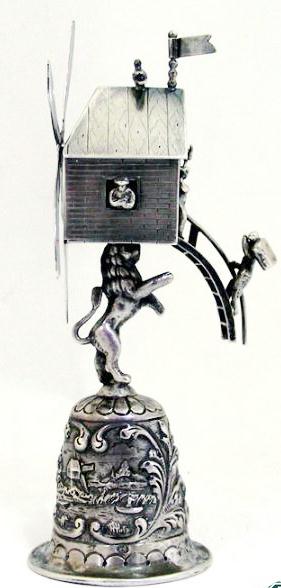
5.5 inches. Nicely done small relief scene of a windmill next to a river with a boat on the side of the cup. “FWTD” has this same cup but someone has converted it into a bell. (It has never been determined if the addition of a bell was done at the workshops or later.) It has the flag on the other end of the roof than shown, an additional staff, and a cast cupid as the supporter and not the lion. Artistic license I suppose.
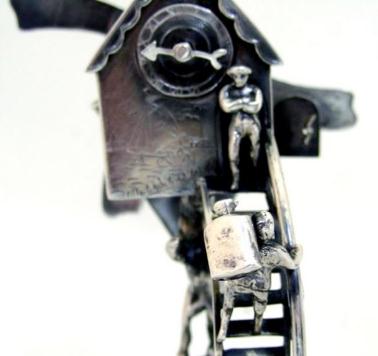
Detail of above: While it is not unusual o have a man walking up the steps, this version with the man carrying a large bag of grain to be ground. The dude with the bag is seen but not often!
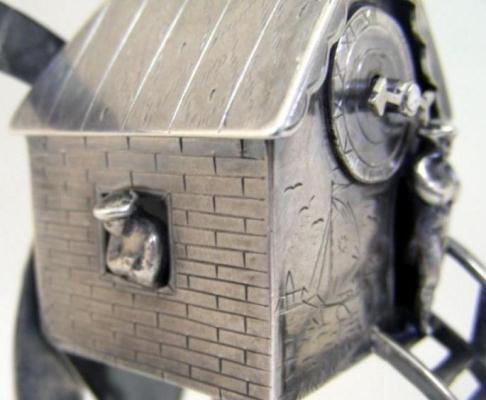
Another detail: The addition of a man inside the house looking outward, is also not seen often either. Please remember silver was not as cheap as it is now and every little addition made the cost of the cup go up!
There are all sorts of variations of ‘the Windmill game’, such as buying the next round of drinks if one could not drink all in the cup in time before the vanes stopped. Some of these cups are rather large and the liquor was hard to swallow.
Another if any booze was spilled,;or having to pay money (or the bar tab) based on the number the pointer stopped on, to betting on who can come closest to any pre-picked number.
The list “of games” is pretty much endless and are very similar to the “dice cup” games, of which there are hundreds. The wind-flag, the rooster (I think) on the thatched roof, and little figures on the bannistered staircase, must have some long forgotten significance – but by the late 1700’s all of the cups evolved to almost always include them. I have one without the cock (not unusual) and I have seen a photo of one without the flag , I can’t say if had been broken off, or not.
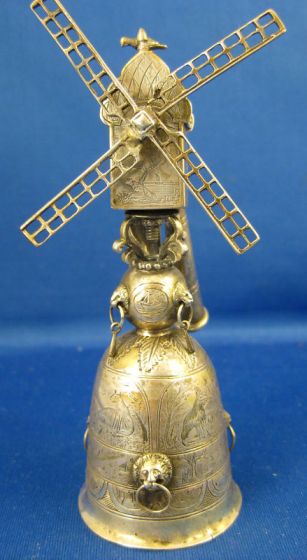
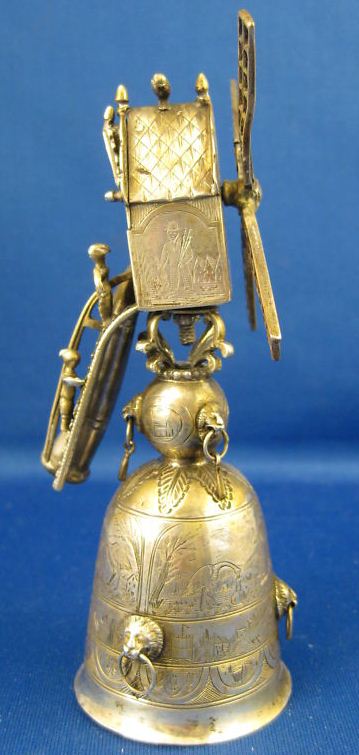
Size is 4 1/8th inches tall. This one is older than most of the rest shown on this page, most likely mid 1700’s.
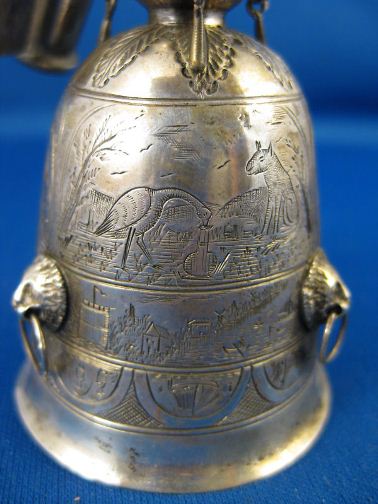
There is more often than not, a bird (a dove or rooster) setting on the ridge line of the house. If one is not found there, look to see if any silver solder is present as lots WERE NOT made with this! (read this Russ?) In fact there is no standard rule for the number of men on the steps, or in the house itself.
Also of note; these cups were not made in pewter, such as the case in “Wedding Cups” (see preceding page on this web site.) Pewter is much too soft an alloy to cast the vanes and other details such as the flag.
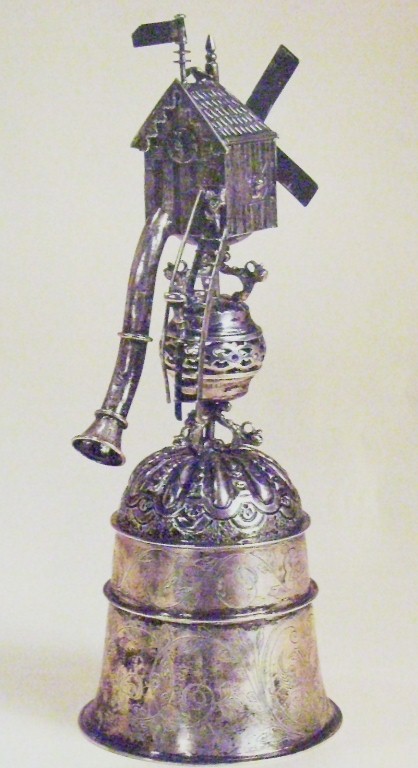
Windmill cup, .835 silver, 8.25 inches tall. Late 1800’s. Offered for sale at J. Vogt’s auction, (Munich) in May 2006. The estimate was 3500 to 5000 EUR. It was not re-listed in his next catalog so it must have sold for at least the minimum. “FWTD” has an identical one but without the bird with no signs of solder, so it didn’t have one when made. One can’t see much in this catalog photo but the entire big cup is engraved and shows a double headed eagle, and florals throughout. There is man carrying a package of grain half way up the steps, but none inside the hut.

The flag on the staff appears to be missing on this example, but at 19 inches tall to the top of the flag staff, it is “very large” for a Windmill Cup.
.

19 inches tall sold by by SOLOMON NYBURG & Co. L, with the original Dutch hallmarks and London Import mark for 1892, including S.N. (for Solomon Nyburg)
Below are other nice examples. If the size is not given it is not known.
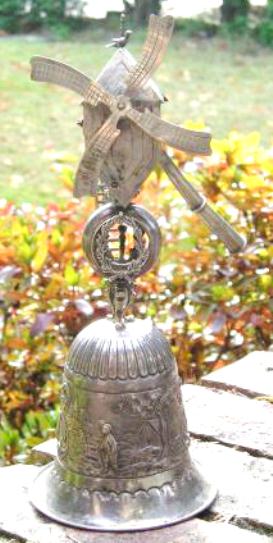
10 inches tall, Dutch, Circa 1880.
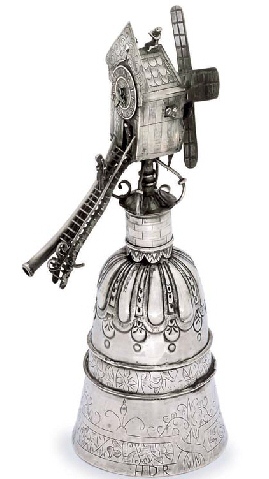
CHRISTIES lot No. ??, 6-07, Estimate was $4,000 TO 6,000 BPS — 7.5 inches.
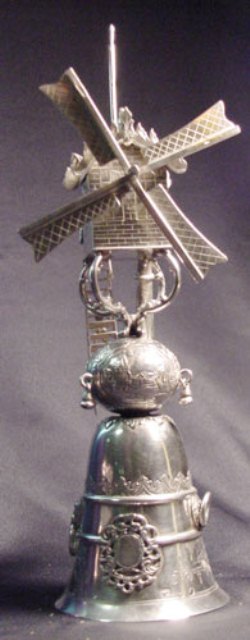
Called a WINDMILL “BEAKER”; 7-2002 @ SOETHBY’S.
Note: No flag is on staff; notice the diminished diameter at the very top of the pole where it would have been.
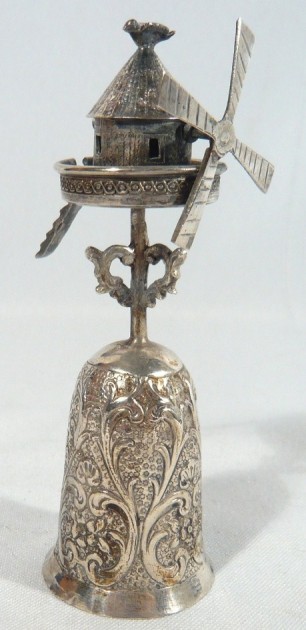
Miniature windmill cup, by KKK = Karl Kurz, repousse, Hanau, Germany. Ca. 1900. A cross between a wedding cup base and a windmill top section. Very different; original? No men and only 4 inches tall!
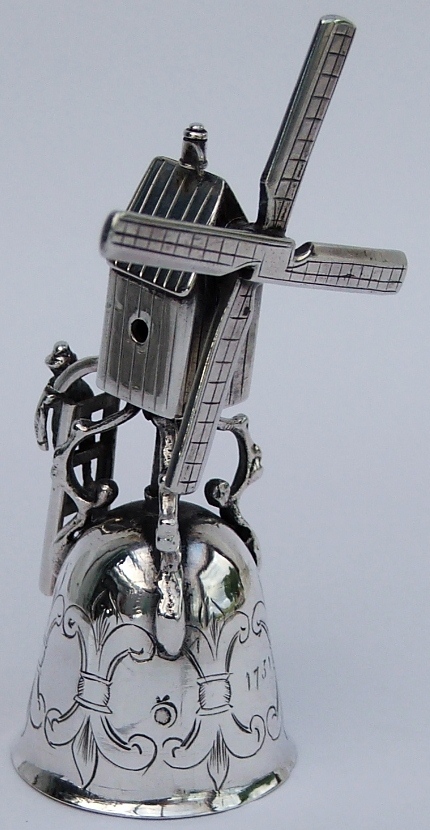
Miniature .3,3 inches tall, silver windmill wager cup, Dated 1751. Doubtful true date! More likely mid 20th century Dutch,
Silver quality mark is a ’10’ = .625 silver. [FWTD]
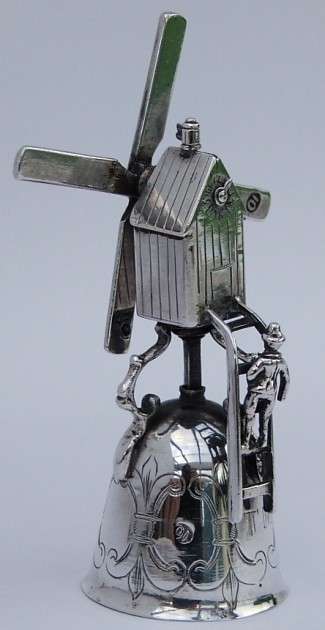
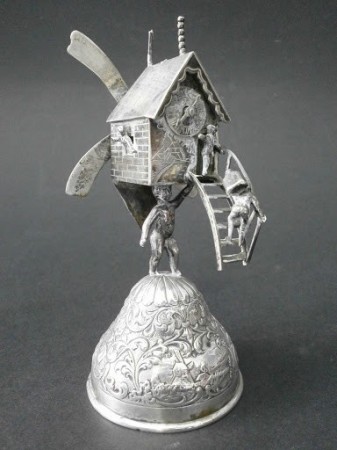
WINDMILL CUP AND BELL – NO BLOW PIPE .
,
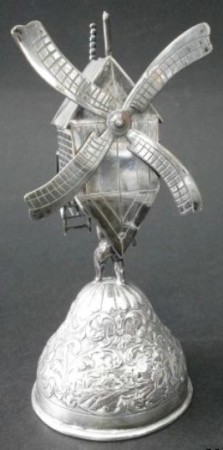

Quoted from the “RIJKSMUSEUM’S ” web site in Amsterdam :
This is a wine glass and it is upside down. It has to be. The glass has no foot to stand on. Instead of a foot, the glass has a silver windmill. On the ladder leading up to the mill is a man, and another is sitting on the roof. The mill is part of a drinking game. The glass is transparent and white. It is made in a pattern of delicately interweaving milk glass and clear glass achieved following an extremely complex method. The result is known as ‘filigrana’. This glass was made in the seventeenth century in Holland in a style referred to as ‘façon de Venise’: in the Venetian manner.
Circa 1642-44 http://www.rijksmuseum.nl/aria/aria_assets/BK-NM-803?lang=en
[END – SOK — 17 – DD]
 “I don’t understand the point of lap dancing clubs. If I wanted a woman to take all my money and sexually frustrate me, I’d stay at home with my wife!”
“I don’t understand the point of lap dancing clubs. If I wanted a woman to take all my money and sexually frustrate me, I’d stay at home with my wife!”

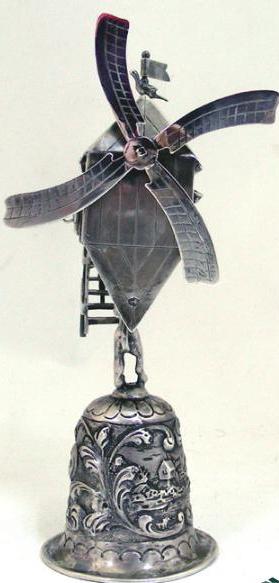
Leave a Reply